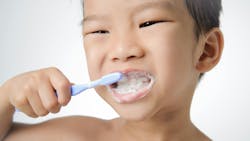How would you like your toothpaste: With or without sodium lauryl sulfate?
Consumers are bombarded with advertisements that state the harms or benefits of products, and toothpaste is no exception. Not only do consumers have the option of toothpastes with or without fluoride; now they’re aware of products with or without sodium lauryl sulfate (SLS).
The purpose of SLS
SLS is a common cleanser and foaming agent that’s been in toothpaste since the 1930s. This common ingredient has been approved by the FDA and deemed safe for oral care products.1 Also, the European Union (EU) and American Cancer Society have determined SLS to be a noncarcinogenic compound that poses no risk to human health when used as an ingredient in toothpaste.2
Toothpaste can contain approximately 0.5% to 2.0% SLS. This surfactant assists in breaking down plaque accumulation and food debris in the oral cavity.3,4 SLS is soluble in water, assists in distributing flavorings throughout the oral cavity, and produces the familiar thick foaming sensation when brushing. Another advantage of SLS is that it decreases surface tension of water, which allows the toothpaste to slide easily between teeth and access other surfaces in the oral cavity.
Want to read more from Melissa?
Best practices for dental unit waterline management
An investigation into the effects of vaping
SLS and the oral mucosa
Although studies have indicated that SLS is a noncarcinogenic compound, research demonstrates that it can cause irritation of the oral mucosa. SLS breaks down the mucosal mucin or the natural lubricant in the mouth while simultaneously working to remove harmful and unwanted debris from the oral cavity. The loss of the natural barrier contributes to oral mucosal irritation and oral mucosal peeling (OMP), and this is directly related to the SLS in toothpaste.
The clinical presentation of oral mucosal irritation can vary from patient to patient, from burning or redness to an itching sensation. OMP appears as sloughing, silvery, thin, and stringy tissue visible on the buccal mucosa. Often the patient is unaware of this condition until it’s noted by a dental professional. A classic presentation of OMP is once the sloughed tissue has been removed, healthy pink mucosa is exposed.5 According to a 2019 study, “There is a causal relationship between toothpastes and mouthwashes with oral mucosal peeling, mostly due to high concentrations of sodium lauryl sulphate in their formulations.”6
Oral conditions and SLS
There is sufficient documentation and studies linking SLS, oral mucosal irritation, and OMP to common oral health conditions. These studies indicate that SLS can increase oral mucosal pain or frequency of oral mucosal irritation occurrences. These include:
- Recurrent aphthous ulcers: This is the most common oral health disease and affects 20%–25% of the population, with a 50% recurrence rate.7
- Lichen planus: An autoimmune disease affecting approximately 2% of the population, lichen planus involves various areas of the oral cavity, including the buccal mucosa.8,9 There are six known subtypes of oral lichen planus.
- Xerostomia: While xerostomia is not an oral disease, it’s an oral condition that can be caused due to medications, cancer treatment, and Sjögren's syndrome.
Alternatives to SLS
It’s important to discuss alternative SLS-free products with patients. These are less irritating and have equivalent antigingivitis properties. However, the foaming properties are not parallel to SLS products. The following is not a comprehensive list, but a starting point to give patients examples of SLS-free toothpaste options.
- Sensodyne (available in some product lines, but not all)
- MI Paste
- Hello TP
- Biotene
- Arm and Hammer
What patients need
Not every patient needs a toothpaste that is SLS-free. Many patients have used their tried-and-true toothpastes for years and have no signs of oral irritation or OMP. For them, there’s no need for alternative recommendations. SLS-free options may be necessary for patients who do have symptoms due to SLS.
Educating patients and allowing them to see what’s occurring in their mouth is often a key component to implementing a change in routine. Access to information is always at consumers’ fingertips, and patients appreciate a starting point when we recommend products and help them filter fact from fiction.
References
- Toothpaste without sodium lauryl sulfate. Arm and Hammer. https://www.armandhammer.com/en/articles/sls-free-toothpaste
- What is sodium lauryl sulfate and is it safe? Colgate. Updated January 9, 2023. Accessed September 1, 2023. https://www.colgate.com/en-us/oral-health/selecting-dental-products/what-sodium-lauryl-sulfate-is-it-safe#
- Chuang AH, Bordlemay J, Goodin JL, McPherson JC. Effect of sodium lauryl sulfate (SLS) on primary human gingival fibroblasts in an in vitro wound healing model. Military Med. 2019;184(3):97-101. doi:10.1093/milmed/usy332.
- Vranic E, Lacevic A, Mehmedagic A, et al. Formulation ingredients for toothpastes and mouthwashes. Bosn J Basic Med Sci. 2004;4(11):51-58. doi:10.17305/bjbms.2004.3362
- Hassona Y, Scully C. Oral mucosal peeling. Brit Dent J. 2013;214(8):374. doi:10.1038/sj.bdj.2013.386
- Perez-Lopez D, Varella-Centelles P, Castelo-Baz P, et al. Oral mucosal peeling related to dentifrices and mouthwashes: a systemic review. Med Oral Patol Oral Cir Buccal. 2019;(24) 4:e452-e460. doi:10.4317/medoral.22939
- Benahmed GA, Noor S, Gasmi A. Oral aphthous: pathophysiology, clinical aspects, and medical treatment. Arch Razi Inst. 2021;76(5):1155-1163. doi:10.22092/ari.2021.356055.1767
- Oral Lichen Planus. Cleveland Clinic. Last reviewed July 25, 2022. Accessed September 15, 2023. https://my.clevelandclinic.org/health/diseases/17875-oral-lichen-planus
- Burkhart N, Rees T. Guidelines–mucosal disorder appointments. Texas A&M University School of Dentistry. Accessed September 16, 2023. https://dentistry.tamu.edu/olp/related-topics/mucosal-disorders.html
About the Author
Melissa Van Witzenburg, MS, RDH
Melissa has been practicing dental hygiene for 23 years. She continues to pursue her passion by educating the aging population about oral health and systemic links. Melissa also works clinically in a periodontal office in the Chicagoland area. For more information, email her at [email protected].

